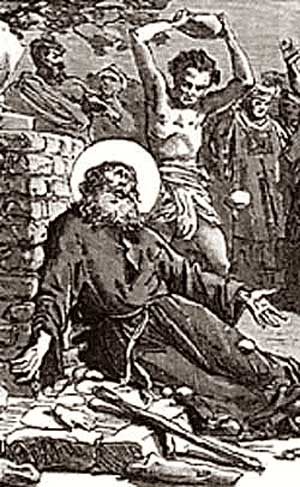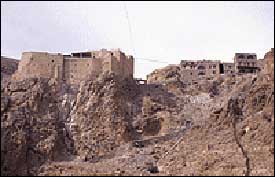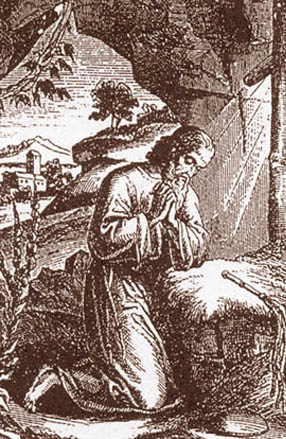 |
The Saint of the Day
St. Abraham of Kidunaia – March 16
Prof. Plinio Corrêa de Oliveira
Biographical selection:
Abraham was born in the 4th century in Mesopotamia not far from Edessa. His parents were wealthy nobles and had great hopes for his future. They planned a marriage for him with a young lady of a family that was also noble and well-to-do. Although Abraham did not want to marry, he did not argue with his parents. A seven-day festivity preceded the marriage. On the last day of the festivities, he slipped away secretly and concealed himself in a cave in the desert, two miles from Edessa.

The idolators of Kidunaia stoned St. Abraham and left him to die
|
A great search was made, and at the end of 17 days, he was found in that cave absorbed in prayer. All appeals for him to reconsider his decision failed, and finally he was left in his solitude. Abraham built a wall closing off his cell, leaving only a small window through which food could be passed. St. Ephraem, his companion and biographer, tells us that he passed ten years in that cell praising God.
When his parents died, he inherited their fortune. He arranged for a friend to manage it, and distributed half of it to the poor. He lived only with a goatskin tunic, a cloak, a bowl to serve as both dish and cup, and a mat of rushes for a bed. Despite his desire for solitude, many people came to him to ask his advice.
One day the Bishop of Edessa asked to speak with him. He told St. Abraham that he wanted the hermit to leave his cell and go to the neighboring city of Beth-Kidunaia, where he had sent many priests, but all had either been driven away or murdered without converting the city from its deeply entrenched idolatry. Abraham saw the will of God in that invitation, and accepted it.
With the money he had entrusted to his friend, he built a Catholic church in the city. The new basilica was protected from the outrage of the idolaters of the city by the laws of Constantine. When it was completed, St. Abraham entered the city at night, toppling and smashing all the altars and idols he could find. The infuriated inhabitants rushed upon him, beat him and drove him from the city. He prayed God to restore his health, and the next morning the people found him, in good health, praying fervently in the church. He continued to harangue the people to leave their superstitions, and they turned on him again. They dragged him out of the city, stoned him and left him for dead. Again, God restored him, and he returned to the church. Ill treated, constantly insulted and sometimes attacked with sticks and stones, he heroically continued to preach and teach for three years without any result.

The desert outside of Edessa in present day Syria
|
At the end of those three years, the people of Kidunaia, facing a complicated problem for which they had no resolution, decided to come and ask his advice, persuaded by his life and charity that he was a holy man. Listening to him talk, all the members of the delegation converted, followed by many in the city. Eventually he baptized 1,000 persons and instructed them in the principles of the Catholic Faith for one year. After that, thinking that he was becoming too absorbed in the things of this world, he decided to leave the people to the care of others. In the silence of the night he left Kidunaia and returned to his cell.
A time passed and he received news that his brother had died and left his only daughter to be raised by him. He brought her to his desert cave, built another cell for her and taught her the things she should know. The girl became a beautiful young lady; one day she was seduced by a renegade monk who had turned from his vows, and followed him to the city. There she spent all the money she had inherited form her father and became a prostitute.
Her uncle did not know what had happened to her. When Abraham finally discovered the truth, he left his solitude. Disguised as a soldier, he went to the city to seek her. Arriving at the inn where she was living, he asked her to sup with him. During the meal, he disclosed his identity. She repented and followed him back to the desert, where she remained until her death, five years after that of her uncle.
St. Abraham lived to the age of 70. As news of his last illness spread, throngs of people from the countryside flocked to his cave to receive his blessing. After his death each one tried to procure some fragment of his clothing, as described by St. Ephraem, who was present.
Comments of Prof. Plinio:
This long and most edifying life of St. Abraham places us in the frank and upright ambience of that era, where the people – even the worst – supported straightforward truths and methods.
This is particularly clear regarding the inhabitants of the city of Kidunaia. They were the worst possible people – idolaters and murderers – who hated the truth and would have killed St. Abraham twice if God had not intervened and restored his health.

St. Abraham chose to return to the desert to continue his life as a hermit
|
Notwithstanding, they were impressed by the attitude of St. Abraham who courageously broke their idols. When a difficult problem arose that they could not solve, they thought to themselves: “Our idols were not able to defend themselves, but this man cured himself when we left him to die. So, his God and not ours must be true.” Or, “He could have fled from here, but he returned. He could be resented against us, but instead he has done much good for us.”
This explains how, after having resisted his presence and teachings for so long a time, they suddenly opened their souls and converted. They were impressed by his action.
Needless to say that St. Abraham breaking all the idols has much significance for our days, which are infected by the spirit of Vatican II’s ecumenism.
Also, we should note his detachment. After he converted the city, he could have lived there comfortably enjoying the fruits of his labor. He did not do that. As soon as his work was done and consolidated, he fled again to his solitude. He only cared about the glory of Our Lady and Our Lord.
We see the same straightforward way of acting when he went to seek out his niece. He was bold enough to enter a house of perdition – and I think that no one should imitate him in this episode, he clearly received a special divine inspiration to do this – and presented himself to the niece as a client. Only then did he disclose his identity. Again, we see his direct method.
His straightforward, frank, clear and positive action was crowned with success. The niece converted and most probably is with him in Heaven glorifying God for all eternity.
He died extraordinarily well; in short, he succeeded in everything he did.
Let us ask the intercession of St. Abraham Kidunaia for the grace to smash the moral idols of the Revolution, internally in our souls and externally in society, with the same courage and straightforwardness.


  | | Prof. Plinio Corrêa de Oliveira | |
The Saint of the Day features highlights from the lives of saints based on comments made by the late Prof. Plinio Corrêa de Oliveira. Following the example of St. John Bosco who used to make similar talks for the boys of his College, each evening it was Prof. Plinio’s custom to make a short commentary on the lives of the next day’s saint in a meeting for youth in order to encourage them in the practice of virtue and love for the Catholic Church. TIA thought that its readers could profit from these valuable commentaries.
The texts of both the biographical data and the comments come from personal notes taken by Atila S. Guimarães from 1964 to 1995. Given the fact that the source is a personal notebook, it is possible that at times the biographic notes transcribed here will not rigorously follow the original text read by Prof. Plinio. The commentaries have also been adapted and translated for TIA’s site.
|
Saint of the Day | Home | Books | CDs | Search | Contact Us | Donate

© 2002- Tradition in Action, Inc. All Rights Reserved
|
 |

|